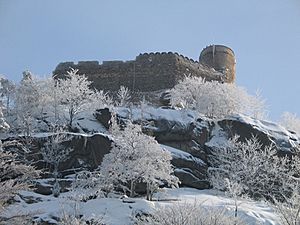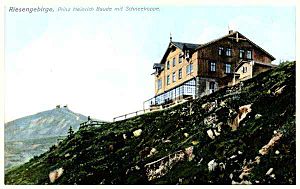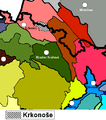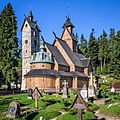Karkonosze facts for kids
Quick facts for kids Krkonoše / Karkonosze |
|
|---|---|

Sněžka – the highest peak of Krkonoše
|
|
| Highest point | |
| Peak | Sněžka / Śnieżka |
| Elevation | 1,603 m (5,259 ft) |
| Naming | |
| Etymology | "krak"+"noš" (see Names) |
| Geography | |
| Countries | Czech Republic and Poland |
| States/Provinces | Liberec Region (CZ), Hradec Králové Region (CZ) and Lower Silesian Voivodeship (PL) |
| Range coordinates | 50°46′N 15°37′E / 50.767°N 15.617°E |
| Borders on | Jizera Mountains and Rudawy Janowickie |
| Subdivisions |
List
Western Krkonoše Mountains
Eastern Krkonoše Mountains Wielki Staw Mały Staw Rivers: Elbe Jizera Úpa Mumlava Bóbr Kamienna |
| Geology | |
| Orogeny |
|
| Age of rock | Neoproterozoic and Paleozoic |
| Type of rock |
|
The Krkonoše or Giant Mountains, are a mountain range located in the north of the Czech Republic and the south-west of Poland, part of the Sudetes mountain system (part of the Bohemian Massif). The Czech-Polish border, which divides the historic regions of Bohemia and Silesia, runs along the main ridge. The highest peak, Sněžka, is the Czech Republic's highest point with an elevation of 1,603 metres (5,259 ft).
On both sides of the border, large areas of the mountains are designated national parks (the Krkonoše National Park in the Czech Republic and the Karkonosze National Park in Poland), and these together constitute a cross-border biosphere reserve under the UNESCO Man and the Biosphere Programme. The source of the River Elbe is within the Krkonoše. The range has a number of major ski resorts, and is a popular destination for tourists engaging in downhill and cross-country skiing, hiking, cycling and other activities.
History
Until the High Middle Ages the mountain range and its foothills were un-populated, with deep, impenetrable forests. The first traces of human settlements probably appeared in the Duchy of Bohemia near two provincial paths between Bohemia and Silesia in the 12th century.
The first wave of colonization by Slavonic settlers goes back to the 13th century in the Kingdom of Bohemia, but only includes the foothills; the mountain ridges were still un-populated. The second wave of colonization of the foothills in the late 13th century was mostly by German settlers where they first colonized the Silesian northern part, where farming conditions were better. Many agricultural settlements, markets and handcraft communities and cities were founded at that time, and they formed a base for the further colonization of the mountain range.
The first people who explored the inner parts of the Krkonoše were treasure hunters and miners looking for gold, silver, ores and valuable stones, mainly on the Silesian side. In the 14th and 15th centuries foreigners who spoke a non-German language came to the mountains. They were called "Wallen" (see Walha), and their journeys to the "treasure" deposits were recorded in so-called "Wallenbüchern" (Wallen books). Mysterious orientation signs from these "Wallen" are visible to this day, especially on the northern side of the mountains.
he Krkonoše is the legendary home of Rübezahl, a half-mischievous, half-friendly goblin of German folklore.
Mountain huts and rock formations
Typical for the Krkonoše are its numerous mountain huts, which are called bouda in Czech and Baude in German. Both names are derived from the Middle High German word Buode, which means booth or building. Entire colonies of mountain huts were called after the families who lived there. They are located in the higher parts or the ridge of the Krkonoše and were used by shepherds as wooden refuges in the summer.
After 1800, some of the mountain huts became interesting for the first hikers, and towards the end of the 19th century many were converted into hostels. Later, these huts were often expanded to host a larger number of guests. In other places, the old mountain huts were replaced by newer buildings which were specially built for tourism purposes. Huts from the 20th century include Petrova bouda (Peterbaude) and the hut on the summit of mount Sněžka/Śnieżka.
There are also many impressive rock formations on the main ridge. These weathered blocks of granite form high towers which often resemble humans or animals, and reach heights up to 30 metres (98 feet).
Images for kids
-
Dead spruces on the northern, Polish side of the range
-
Koppenträger, who in former times supplied the mountain huts during most of the year. The picture shows members of the Hofer and Mitlöhner families, two long-established dynasties from the eastern part of the Bohemian side of the mountains. The ancestors of both families came from Austria in the 16th century.
-
Morning in the Riesengebirge, early 1810s painting by Caspar David Friedrich
-
A Ski resort in Pec pod Sněžkou
-
Riſenberg on Martin Helwig's map of Silesia, 1561
-
Panorama of the Giant Mountains from the south (from the Czech Republic
-
Panorama of Giant Mountains from the north (from Poland) in winter
-
Panorama of Giant Mountains from the north (from Poland) in summer
-
Panorama of Giant Mountains from the north (from Poland) in winter
See also
 In Spanish: Montañas de los Gigantes para niños
In Spanish: Montañas de los Gigantes para niños


















